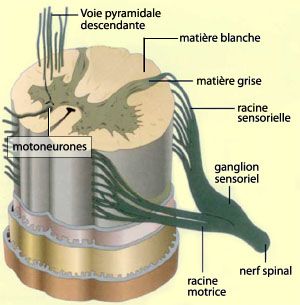-
 Donders rings
Donders rings
-
 Orphan disease
Orphan disease
-
 Deep Space Network
Deep Space Network
-
 Albinism
Albinism
-
 Virtual circuit
Virtual circuit
-
 WMAP Satellite
WMAP Satellite
-
 Epithelium
Epithelium
-
 Genome
Genome
-
 Greenstick fracture
Greenstick fracture
-
 Electron transfer chain
Electron transfer chain
-
 Flat truss
Flat truss
-
 Mineral carbonation
Mineral carbonation
-
 Ginkgo
Ginkgo
-
 Pink moon
Pink moon
-
 Thorax
Thorax
-
 Rillwash
Rillwash
-
 Nanofiltration
Nanofiltration
-
 Asbestos
Asbestos
-
 Work hardening
Work hardening
-
 Abyssal zone
Abyssal zone
-
 MPEG
MPEG
-
 Phoresy
Phoresy
-
 Raspberry
Raspberry
-
 Transduction
Transduction
-
 Volcanic arc
Volcanic arc
-
 Oedema
Oedema
-
 Serpentine
Serpentine
-
 Luminance
Luminance
-
 PCT
PCT
-
 Gangue
Gangue
Spinal cord
The spinal cord is part of the central nervous system.
Function of the spinal cord
The spinal cord is the extension of the brain from the cranial vault from the brain stem along the vertebral column in which it is contained. Its role is to distribute nerves from the brain to the different parts of the body.
It is involved in reflexes, such as taking your hand directly away from a burning cooker ring, directly without nerve information passing to the brain.
Structure of the spinal cord
The spinal cord is a white cord approximately 1 cm in diameter and 50 cm long. It has two swellings where the limbs emerge and ends in a point at the second lumbar vertebra. There are 31 pairs of spinal nerves (left and right), which are directly connected to the spinal cord. Each nerve has two nerve roots:
- posterior or sensitive root;
- anterior or motor root.
The spinal nerves are all mixed: motor or sensory.
Two regions are seen on transverse section of the spinal cord:
- Firstly, the grey matter (H shaped) in the centre containing the cell bodies of neurones.
- Secondly, the grey matter in the periphery which contains axons in their myelin sheath.

The spinal cord is part of the central nervous system and is an extension of the brain. © psychologie-m-fouchey.psyblogs.net
Latest
Fill out my online form.



